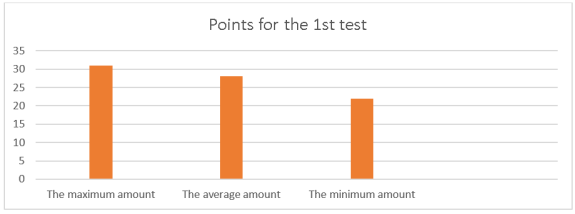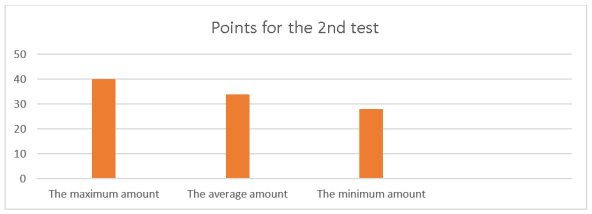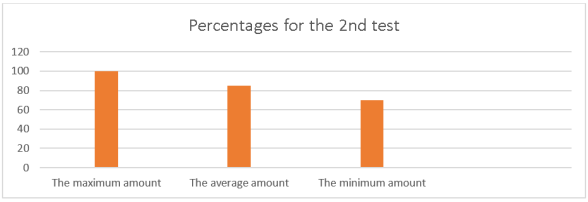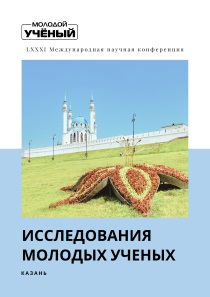Ideographic dictionaries as a means of improvement of the bachelor degree’s 1st year students’ lexical skills
Авторы: Исмаилова Гайнигуль Кабидуллиновна, Оралгазина Аяулым Оралгазыевна
Рубрика: 24. Педагогика
Опубликовано в
LXXXI международная научная конференция «Исследования молодых ученых» (Казань, май 2024)
Дата публикации: 04.05.2024
Статья просмотрена: 13 раз
Библиографическое описание:
Исмаилова, Г. К. Ideographic dictionaries as a means of improvement of the bachelor degree’s 1st year students’ lexical skills / Г. К. Исмаилова, А. О. Оралгазина. — Текст : непосредственный // Исследования молодых ученых : материалы LXXXI Междунар. науч. конф. (г. Казань, май 2024 г.). — Казань : Молодой ученый, 2024. — С. 93-93. — URL: https://moluch.ru/conf/stud/archive/515/18508/ (дата обращения: 20.05.2024).
Lexical skills are an essential component of foreign language competence. One of the most well-known ways to expand vocabulary is using dictionaries. Ideographic dictionaries, being collections of words by concepts, are an excellent tool for developing the lexical skills of the bachelor degree’s 1st year students, as this allows them to fully assimilate the theme being studied and systematically memorize new lexical units. This paper discusses the effectiveness of using ideographic dictionaries in teaching English to 1st year bachelor degree’s students and demonstrates the results of research conducted on this issue. The purpose of this article is to explain the concept of ideographic dictionaries and to prove their usefulness in developing the lexical skills of English students of the 1st year of Bachelor's degree.
Keywords: methodology TESOL, dictionaries, ideographic dictionaries, Bachelor degree’s 1 st year students, English language, lexical skills, vocabulary.
Лексические навыки являются важным компонентом иноязычной компетенции. Одним из наиболее известных способов расширения словарного запаса является использование словарей. Идеографические словари, представляющие собой сборники слов, сгруппированных по концептам, являются отличным инструментом для развития лексических навыков студентов 1 курса бакалавриата, поскольку это позволяет им полностью усваивать изучаемую тему и системно запоминать новые лексические единицы. В данной статье рассматривается эффективность использования идеографических словарей при обучении английскому языку студентов 1 курса бакалавриата и демонстрируются результаты исследования, проведенного по этому вопросу. Цель этой статьи — объяснить концепцию идеографических словарей и доказать их ценность для развития лексических навыков студентов английского языка на 1-м курсе бакалавриата.
Ключевые слова: методология преподавания английского как второго иностранного языка, словари, идеографические словари, студенты 1 курса бакалавриата, английский язык, лексические навыки, словарный запас.
Introduction
Vocabulary in the system of linguistic means is an essential component of each type of speaking activity: oral, listening, speaking, as well as writing activities — reading and writing[1, p. 151].
A word is a unit of speech that serves to express a separate concept. It is the center of everything in the foreign language space. If lexical competence is a part of foreign language competence, then words are elements of lexical competence.
English vocabulary is one of the most extensive amongst the world’s languages, so one should study it properly and extensively [2, p. 44].
At the moment, more and more attention is being paid to the development of vocabulary [3, p. 135]. One of the most common ways to replenish knowledge of the lexicon is the use of dictionaries. A dictionary is a collection of words of any language, with interpretation or with translation. Dictionaries have no equal as sources of words and information about them [4, p. 281]. At the moment, there are a large number of dictionaries which anyone can use. However, ideographic ones stand out among them, which differ from the more conventional and familiar ones in that the words there are presented not in alphabetical order, but by conceptions. An ideographic dictionary is a linguistic dictionary in which the lexical composition of a language is presented in the form of systematized groups of words which are more or less close in meaning. The main task of such dictionaries is to describe sets of words united by a common concept — this makes it easier for the individual to choose the most appropriate lexical units for adequate expression of thought and promotes active language proficiency.
Lexical skill occupies an important place in the system of teaching a foreign language, as it reflects the relationship between words and summarizes information [5, p. 144]. That is why students of the 1st year of the bachelor's degree must build a solid lexical base for successful academic activity, productive mastery of the English language and acquisition of foreign language competence. During the course of study, students must learn the meanings of units and be able to use them, master the skills of lexical design of speech and learn to understand lexical units [6, 105]. To do this, it becomes necessary to determine the most effective tool which will help them achieve these tasks.
Each individual denotes in words any material and immaterial objects and phenomena. It is through words that any language is connected to the surrounding reality [7, p. 39]. When learning new words, ideographic dictionaries are a useful assistant and an indispensable means of broadening the vocabulary of bachelor degree’s 1 st year students, as they allow for a wide and complete study of targeted topics. Usually textbooks used for learning English present new lexis in the form of small «word boxes», which, undoubtedly, is not enough for extensive assimilation of the topic, detailed study of words in order to be able to then maintain a conversation on a particular topic using them.
That is why ideographic dictionaries have a huge advantage in the space of learning English: 1st year students need a thorough study of concepts and semantic groups by topic, so that later they can use this thorough knowledge in future activities. Furthermore, as they have just graduated from school and are not used to conducting an independent detailed search and examination of vocabulary on a particular topic, the manual, which is a ready-made collection of terms, is the most convenient means for them to develop their vocabulary.
Literature review
As Kuznetsova Yu. G. notes, ideography is one of the youngest sections of lexicography. It is not surprising that ideographic dictionaries have recently begun to be valued and studied more and more. It can also be said that in addition to vocabulary development, they also demonstrate to students how extensive and rich all of the existing word concepts and thematic groups are. Ideographic dictionaries reflect the systemacity of lexis, since with their help visual grouping and systematization of lexical units are realized in relation to semantic correlations that are between words [8, p. 114].
A. M. Plotnikova and M. V. Slautina prove the usefulness of ideographic dictionaries, arguing that they serve as a means of studying linguistic conceptualization and categorization of the world and, consequently, become a source of linguistic and cultural information significant for intercultural communication. Additionally, being dictionaries of the active type, they serve the implementation of communicative tasks, and the principle of consistency corresponds to the peculiarities of the organization of the human cognitive system and mental lexicon [9, p. 173].
G. Y. Bogdanovich and A. Ya. Martynyuk emphasize that ideographic dictionaries, by the very fact of placing words related in meaning next to each other, teaches to predict various syntactic and semantic variations [10, p. 141]. In the formation of lexical competence, this gives an advantage to students using ideographic dictionaries — since the development of lexical skills is not only the study of new words, but also the formation of the ability to predict certain variations, noticeable connections between words, the meanings of certain lexical units.
All in all, we can note that ideographic dictionaries are highly regarded in the modern day and linguists actively promote its usefulness and value.
However, in order to thoroughly study the matter and examine the connection between the use of ideographic dictionaries and the level of lexical skills of the 1 st year students, the research was conducted.
Methodology
We first conducted a questionnaire in order to gather data about the general attitude of students towards ideographic dictionaries and their concept, using the method of surveying the research’s 23 participants, bachelor degree’s 1 st year students of the specialty «Foreign language: two foreign languages».
Table 1
|
Question |
Answer |
Answer |
Answer |
|
Are you familiar with the concept of ideographic dictionaries? |
No, I am not familiar with the concept of ideographic dictionaries |
Yes, I am familiar with the concept of ideographic dictionaries, but I haven’t used them |
Yes, I am familiar with the concept of ideographic dictionaries and I have used them |
|
75 % |
15 % |
10 % |
|
|
Would it be easier for you to work with a dictionary that groups words by concept or semantic relation instead of arranging them in alphabetical order? |
Yes, it would be easier for me to work with such a dictionary |
I’m not sure if I would have felt the difference |
No, it would be more difficult for me to work with such a dictionary |
|
74,3 % |
2 5 % |
0,7 % |
|
|
Ideographic dictionary is a dictionary that groups words by concept or semantic relation instead of arranging them in alphabetical order. Would you consider ever using an ideographic dictionary? |
I would like to try using an ideographic dictionary |
I would try to use it, but I probably wouldn’t continue to use it any further |
I am not interested in using an ideographic dictionary |
|
75 % |
1 9 ,9 % |
5,1 % |
|
|
If you’re not interested in using ideographic dictionaries, what would make you interested in giving it a try? |
I’m already interested in using an ideographic dictionary |
I would become interested in using an ideographic dictionary, if there was a scientific work proving its usefulness |
I would become interested in using an ideographic dictionary if someone recommended me to use it |
|
75 % |
17 % |
0,8 % |
|
|
Ideographic dictionaries provide people with the whole group of words that correspond to a certain idea, while regular ones don't have this aspect. How valuable do you think ideographic dictionaries are? |
Very valuable |
Moderately valuable |
Not valuable at all |
|
77,1 % |
15,9 % |
0,7 % |
Analyzing the results, it can be said that there was a general positive attitude from students towards the concept of ideographic dictionaries and their use, with most of them not having had been familiar with such dictionaries before answering this questionnaire and learning about it in it. Students who were not sure if the use of an ideographic dictionary would actually make a difference in their level of lexical skills, voted mostly for the answer saying that their opinion could change if there was a scientific work proving its usefulness. Mostly, however, students demonstrated the interest towards ideographic dictionaries.
The next stage of the study was conducting an experiment. We needed to gather data on the initial level of lexical knowledge of the students. To do that, we analyzed their results from the lexical test where the maximum possible number of points was 40.
Table 2
|
Number |
Student |
Points |
Percentages |
|
1 |
AA |
30 |
75 % |
|
2 |
AA2 |
27 |
67,5 % |
|
3 |
BA |
31 |
77,5 % |
|
4 |
BB |
27 |
67,5 % |
|
5 |
BZH |
30 |
75 % |
|
6 |
GA |
24 |
60 % |
|
7 |
EA |
28 |
70 % |
|
8 |
EA2 |
31 |
77,5 % |
|
9 |
ES |
30 |
75 % |
|
10 |
ZHZH |
28 |
70 % |
|
11 |
KB |
31 |
77,5 % |
|
12 |
MZH |
25 |
62,5 % |
|
13 |
NA |
28 |
70 % |
|
14 |
NA2 |
23 |
57,5 % |
|
15 |
NZH |
31 |
77,5 % |
|
16 |
SA |
30 |
75 % |
|
17 |
SN |
27 |
67,5 % |
|
18 |
TA |
27 |
67,5 % |
|
19 |
TN |
30 |
75 % |
|
20 |
TS |
22 |
55 % |
|
21 |
UN |
30 |
75 % |
|
22 |
KHI |
24 |
60 % |
|
23 |
KHE |
30 |
75 % |
|
Average amount of points: 28 |
Average amount of percentages : 7 0 % |
||
After that, we included the active use of an ideographic dictionary in the process of teaching English to the students and examined their progress, applying the method of observation. Throughout the month of working with an ideographic dictionary, we noticed that students started to understand semantic groups better and started using a wider range of words in each lesson. To document the changes precisely, though, we conducted the test once again.
Table 3
|
Number |
Student |
Points |
Percentages |
|
1 |
AA |
38 |
95 % |
|
2 |
AA2 |
32 |
80 % |
|
3 |
BA |
35 |
87,5 % |
|
4 |
BB |
40 |
100 % |
|
5 |
BZH |
35 |
87,5 % |
|
6 |
GA |
28 |
70 % |
|
7 |
EA |
34 |
85 % |
|
8 |
EA2 |
35 |
80 % |
|
9 |
ES |
33 |
82,5 % |
|
10 |
ZHZH |
30 |
75 % |
|
11 |
KB |
40 |
100 % |
|
12 |
MZH |
32 |
80 % |
|
13 |
NA |
34 |
85 % |
|
14 |
NA2 |
28 |
70 % |
|
15 |
NZH |
33 |
82,5 % |
|
16 |
SA |
40 |
100 % |
|
17 |
SN |
33 |
82,5 % |
|
18 |
TA |
35 |
87,5 % |
|
19 |
TN |
34 |
85 % |
|
20 |
TS |
30 |
75 % |
|
21 |
UN |
36 |
90 % |
|
22 |
KHI |
30 |
75 % |
|
23 |
KHE |
37 |
92,5 % |
|
Average amount of points: 3 4 |
Average amount of percentages : 84, 7 % |
||
Findings
We can see the clear progress between the results of the first test and the results of the second test. Let’s compare both the amounts of points of the students for the tests and the amounts of percentages for the tests. To do that, we created diagrams and visually demonstrated the maximum amounts, average amounts and minimum amounts of points which students got for the tests.

Fig. 1
Here the diagram visually demonstrates that the maximum amount of points for the 1 st test was 31, the average amount of points was 28 and the minimum amount was 22.
Now let’s look at the diagram presenting the amounts of points for the 2 nd test.

Fig. 2
Here we can see that the maximum amount of points for the 2 nd test was 40, the average amount of points was 34 and the minimum amount was 28.
Now let’s compare the results in percentages.

Fig. 3
Here the diagram demonstrates that the maximum amount of percentages for the 1 st test was 77,5 %, the average amount was 70 % and the minimum amount was 55 %.
Let’s move on to the numbers of percentages for the second test.

Fig. 4
Here the diagram demonstrates that the maximum amount of percentages for the second test was 100 %, the average amount was 84,7 % and the minimum amount was 70 %.
Discussion
The average amount of points for the lexical test had increased by 6 points, from 28 to 34 points. The average amount of percentages of points for the lexical test had increased by 14,7 %, from 70 % to 84,7 %.
Undoubtedly, the research showed that the use of ideographic dictionaries does affect the level of the lexical skills of the 1 st year students. By learning words systemically, one is able to improve their lexis, as it is easier to remember related conceptions, chains of words, and as ideographic dictionaries contain more words than what is usually presented in the textbooks, it is broadening the lexical knowledge of students on a bigger scale.
It took students a bit of time to get used to the way ideographic dictionaries are designated, but they were interested by what such a dictionary could provide and the idea of studying themes more thoroughly served as an incentive for them.
Conclusion
The study investigated the effect of the ideographic dictionaries on one’s lexical knowledge and showed that it is effective to use ideographic dictionaries as a means of improvement of the bachelor degree’s 1 st year students’ vocabulary knowledge. To do that, a survey and an experiment were conducted. It can be concluded that even before implementing the use of an ideographic dictionary, students generally show positive attitude towards the perspective of using it. The observation and the results of the 1 st and 2 nd test which were conducted before and after implementing such a dictionary demonstrated the significant progress in the lexical skills of the Bachelor degree’s 1 st year students.
The research showed that with the use of an ideographic dictionary the level of lexical storage of the students can increase by 14,7 %. While the effects of the implementation of such a dictionary on one’s lexicon may differ from an individual to an individual, it can be concluded that generally it will result in a more broadened knowledge of lexical units and especially lexical chains.
The investigation revealed that using an ideographic dictionary in the foreign language learning space is a useful tool for developing lexical skills. Bachelor degree’s 1 st year student certainly benefit from the use of ideographic dictionaries in the space of learning English as a second language.
Recommendations
Despite the fact that ideographic dictionaries contain more words on themes than textbooks, it is optimal to study 14–15 words per lesson so as not to overload students. The words on the topics should be divided into several lessons or left for homework and not studied all at once in one lesson, because the attempt to do that would not be efficient.
We also recommend to not only provide students with the ready-made systems of words from the ideographic dictionary, but also assign them exercises where they would have to create systemic word groups of their own — they need not only to learn what the dictionary has to present, but also understand how to create «word nests» in order to train their brain in relation to semantic systems and chains of words.
References:
- Netrebina A. A. The essence of lexical skills. Classification of lexical skills // Professional community of foreign language teachers of the XXI century: materials of the All-Russian scientific practical conference with international participation / Shadrinsk State Pedagogical University. — Shadrinsk: SSPU, 2017. — P. 151–154.
- Antrushina G. B. Lexicology of the English language: An educational manual for students. / G. B. Antrushina, G. M. Sukhova, A. A. Grigoryan. — Moscow: Printed word, 2012. — 248 p.
- T. Kurochkina. A. The use of dictionaries in teaching vocabulary in foreign language classes. / T. A. Kurochkina, R. R. Syrtlanova // Theory and practice of language communication: XII International Scientific and Methodological Conference, 2020. — Ufa: USATU, 2020. — 126–135 p.
- Syrtlanova R. R. The use of collections in foreign language classes // Theory and practice of language communication. XI International Scientific and Methodological Conference. — Ufa: USATU, 2019. — P. 280–286.
- Embergenova A. Zh. Technology for the development of students' lexical skills in English classes // The international scientific journal «Symbol of Science». — Ufa: Omega science, 2023. № 12(1) — P. 142–145.
- Startseva A. N. Definition of the concept of «lexical skill», features of the formation of lexical skills at the senior stage of education // Scientific and technical progress: information, technologies, mechanism: A collection of articles based on the results of the International Scientific and Practical Conference. — Sterlitamak: IRA, 2023. — P. 38–41.
- Kotlova M. V. Formation of lexical skills of the university students / M. V. Kotlova // Innovations in professional education, Tyumen, 2013 / Proceedings of the International Scientific and Practical Conference. — Tyumen: TSOGU, 2013. — P. 103–108.
- Kuznetsova Yu. G. The implementation of the ideographic principle in the lexicography of the modern English language // Philological Sciences. Questions of theory and practice. — Tambov: Diploma, 2015. № 12(54) — P. 113–116.
- Plotnikova A. M. Ideographic dictionaries in the practice of teaching linguistic disciplines / A. M. Plotnikova, M. V. Slautina // Perspectives of Science & Education. International Scientific Electronic Journal. — Voronezh: Scientific and educational initiative, 2019. № 6 (42). — P. 172–182.
- The experience of ideographic description of languages (background of the matter) / A. Ya. Martynyuk, G.Yu. Bogdanovich // Culture of the peoples of the Black Sea region. — Simferopol: Tavria, 2003. № 37. — P. 140–149.











